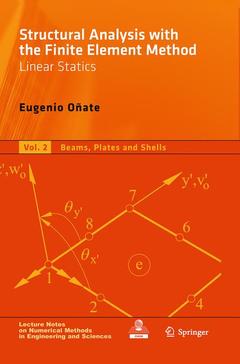Description
Structural Analysis with the Finite Element Method. Linear Statics, Softcover reprint of the original 1st ed. 2013
Volume 2: Beams, Plates and Shells
Lecture Notes on Numerical Methods in Engineering and Sciences Series
Language: English
Subject for Structural Analysis with the Finite Element Method...:
Keywords
Publication date: 08-2016
Support: Print on demand
Publication date: 02-2013
864 p. · 16x24 cm · Hardback
Description
/li>Contents
/li>Comment
/li>
STRUCTURAL ANALYSIS WITH THE FINITE ELEMENT METHOD
Linear Statics
Volume 1 : The Basis and Solids
Eugenio Oñate
The two volumes of this book cover most of the theoretical and computational aspects of the linear static analysis of structures with the Finite Element Method (FEM). The content of the book is based on the lecture notes of a basic course on Structural Analysis with the FEM taught by the author at the Technical University of Catalonia (UPC) in Barcelona, Spain for the last 30 years.
Volume1 presents the basis of the FEM for structural analysis and a detailed description of the finite element formulation for axially loaded bars, plane elasticity problems, axisymmetric solids and general three dimensional solids. Each chapter describes the background theory for each structural model considered, details of the finite element formulation and guidelines for the application to structural engineering problems. The book includes a chapter on miscellaneous topics such as treatment of inclined supports, elastic foundations, stress smoothing, error estimation and adaptive mesh refinement techniques, among others. The text concludes with a chapter on the mesh generation and visualization of FEM results.
The book will be useful for students approaching the finite element analysis of structures for the first time, as well as for practising engineers interested in the details of the formulation and performance of the different finite elements for practical structural analysis.
STRUCTURAL ANALYSIS WITH THE FINITE ELEMENT METHOD
Linear Statics
Volume 2: Beams, Plates and Shells
Eugenio Oñate
The two volumes of this book cover most of the theoretical and computational aspects of the linear static analysis of structures with the Finite Element Method (FEM).The content of the book is based on the lecture notes ofa basic course on Structural Analysis with the FEM taught by the author at the Technical University of Catalonia (UPC) in Barcelona, Spain for the last 30 years.
Volume 2 presents a detailed description of the finite element formulation for analysis of slender and thick beams, thin and thick plates, folded plate structures, axisymmetric shells, general curved shells, prismatic structures and three dimensional beams. Each chapter describes the background theory for each structural model considered, details of the finite element formulation and guidelines for the application to structural engineering problems Emphasis is put on the treatment of structures with layered composite materials.
The book will be useful for students approaching the finite element analysis of beam, plate and shell structures for the first time, as well as for practising engineers interested in the details of the formulation and performance of the different finite elements for practical structural analysis.
1. Introduction to structural analysis by the Finite Element Method. 2. 1D finite elements for axially loaded rods. 3. Advanced 1D rod elements and requirements for the numerical solution. 4. 2D solids. Linear triangular and rectangular elements. 5. 2D solids. Higher order elements. Shape functions and isoparametric formulation. 6. Axisymmetric solids. 7. Three dimensional solids. 8. Bending of slender beams. Euler-Bemouilli theory. 9. Thick/slender beams. Timoshenko theory. 10. Thin plates. Kirchhoffs theory. 11. Thick/thin plates. Reissner-Mindlin theory. 12. Analysis of shells using flat elements. 13. Axisymmetric shells. 14. Analysis of arbitrary shape shells using degenerate solid elements. 15. Three-dimensional rods and shell stiffness. 16. Prismatic structures. Finite strip and finite prism methods. 17. Miscellaneous: inclined supports, displacements, constrains, nodal condensation error estimation and mesh adaptivity etc. 18. Pre and post-processing. Mesh generation and visualization of computer results. 19. Introduction to FEM programming.

